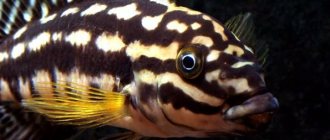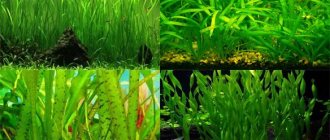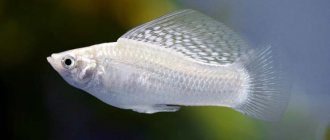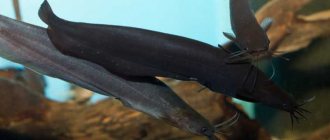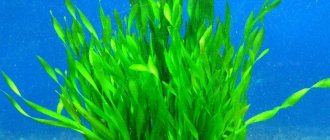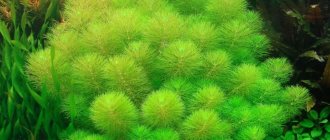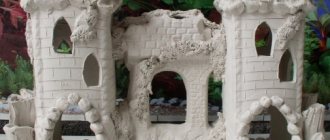general description
The popular aquarium plant looks like a tall bush consisting of ribbon-shaped bright green leaves . Depending on the type, they can be straight or twisted into a spiral.
The length of the leaves varies from 20 cm to 1 meter. They grow from one basal rosette, stretching along the height of the water column. They do not go beyond the surface of the water, lying on it.
To prevent waterlogging, it is recommended to regularly update the planting, removing specimens that have grown greatly in height.
The root system is moderately developed. Long, up to 10 cm, roots allow the bushes to gain a good foothold in the ground.
Under good conditions, Vallisneria can bloom , but its corollas are so small and inconspicuous that they do not add decorative value.
Habitats in nature
Vallisneria can be found on all continents of the Earth. It has adapted to live in stormy rivers, and in stagnant lakes and ponds, and is tolerant of temperature conditions.
On the territory of our country, it has populated the reservoirs of the Ciscaucasia and the Far East ; there are extensive growths of it on the lower Volga.
How to plant a plant in an aquarium
For planting, choose young shoots of Vallisneria, they will take root better. The leaves should be bright and fresh, without damaged areas. Pay attention to the roots too - healthy roots are white, elastic, 5-10 cm long.
Plant the plant on the sides of the aquarium or against the back wall. Vallisneria grows very quickly, forming a green wall. You can plant dwarf Vallisneria in the center of the tank.
Rules for planting Vallisneria:
- Before planting, rinse the plant with warm water. You can also rinse Vallisneria for 5 minutes in a slightly salted solution (1 teaspoon of table salt per liter of water). This is done to remove harmful organisms that may enter the aquarium along with the plant.
- Make a small hole in the soil and place the plant. Straighten the roots so that they do not bend.
- Fill with soil, without compacting it too much, so as not to damage the root system. Please ensure that the growth bud remains on the surface of the substrate.
If Vallisneria is planted correctly, it quickly takes root, grows and multiplies.
Popular species among aquarists
The perennial herbaceous plant belongs to the Aquaticaceae family. The first description of the species was made by Carl Linnaeus , and this happened in 1753. He gave it a name in honor of the Italian botanist Antonio Vallisneri. Today the genus is represented by 14 species.
Interesting! The requirements for living conditions are approximately the same for all species. By sticking to averages, you can count on success.
Giant Vallisneria
It is gigantic because its leaves grow 2 meters in length. The width of the leaf blades is 4 cm. This impressive plant also requires spacious aquariums, where it fully reveals its beauty.
The water space looks especially impressive when planting giant Vallisneria along the walls of the aquarium.
Spiral or ordinary
The generic definition of “spiral,” oddly enough, is associated not with the leaves, but with the shape of the peduncle: in female flowers, the stalk of the peduncle is twisted into a spiral.
Vallisneria spiralis is characterized by rapid growth, reaching a length of 40 cm.
Dwarf or nana
The name of this species also has its own paradox. Vallisneria nana is not inferior in growth to other varieties; its leaves stretch up to 60 cm in height.
It is called dwarf for its very narrow leaf blades, painted dark green. Prefers to grow under bright light and temperatures of 25...28 °C.
American
The genus includes two species: narrow-leaved and broad-leaved. The width of the leaves in the first species is 10 mm, in the second - 20–25 mm. The plant is low, up to 20 cm, the leaves are ribbon-shaped, with visible veins. The roots are short but strong.
Tiger
The tiger or spotted (new classification name) has long, up to 60 cm, leaves painted with black strokes. They give the leaves a resemblance to tiger skin.
Nathans
One of the varieties of American Vallisneria with very long, up to 1 meter, leaves. In a small aquarium it adapts to the volume of water and does not grow more than 40–50 cm. The leaves are narrow and thin.
Twisted-leaved
The peculiarity of the species is leaves twisted with a screw. Vallisneria torsionum loses its decorative effect in poor lighting: its leaves become elongated and it becomes similar to its ordinary appearance. Leaf length 40 cm.
Asian
Coming from Japan and some Asian countries, the Asian species is unpretentious in maintenance. Dense bushes stretch 50 cm in height. In bright light, the leaves lose turgor and droop.
Attention! It grows quickly and requires regular thinning.
Content Features
Vallisneria is an absolutely undemanding plant that is suitable even for beginner aquarists. It is resistant to temperature changes, but at very low temperature conditions its growth processes slow down significantly. Vallisneria reacts negatively to very high levels of water hardness, while its leaf blades become smaller and pale, and growth stops.
The plant itself performs a filtering function, and therefore can remain in old water for quite a long time. But to ensure the health and attractive appearance of Vallisneria, it is recommended to periodically change the water in the aquarium, as well as purchase and install a special filter.
This crop can easily do without fertilizing and mineral fertilizers. But for normal growth and full development, it requires nutritious, soft, sufficiently silted soil. River sand or fine gravel is well suited for planting Vallisneria.
With insufficient lighting, the plant begins to stretch, and its leaf blades acquire an unhealthy yellow tint, fade and lose their beauty. To avoid such problems, aquarists are recommended to use additional lighting in the form of LEDs and fluorescent lamps. Vallisneria responds especially well to natural sunlight.
This plant has the property of rapid growth and shading of the water surface.
In cases where the thickets of Vallisneria become too dense and create a lack of light for other crops and aquarium inhabitants, it is necessary to thin out the plant, removing it along with the rhizome.
Experts do not recommend trimming the tops of Vallisneria, since after such a procedure its leaves turn pale and begin to rot. In addition, the main cause of plant disease is low quality tap water. To grow Vallisneria, it is recommended to use filtered, pre-purified water.
Is it difficult to maintain?
Keeping Vallisneria in an aquarium is quite simple. She is quite satisfied with the conditions created for tropical fish: warm water, comfortable lighting and a certain water hardness .
Most beginners who turn to aquarium farming for the first time choose this plant for their home pond.
Conditions in the aquarium
If the soil is primarily important for domestic plants, then for aquatic species it is the water parameters. First of all , the water poured into the aquarium must be cleared of salts and impurities that negatively affect the plant.
Most species prefer medium hardness (from 5 to 8 pH). Temperature conditions can vary between 23...32 °C. At 15...18 °C it withers.
In moderate lighting, daylight hours should last at least 8 hours . In winter, its duration is maintained using fluorescent lamps.
View this post on Instagram
Publication from guppi.ru (@guppi.ru) July 27, 2021 at 5:26 PDT
How to plant in an aquarium? Vallisneria bushes are planted in an even row, closer to the filter and the rear walls of the aquarium (can be placed along the side walls).
The water fluctuations caused by the filter straighten the leaves so that they grow properly and look beautiful in an artificial pond.
Attention! When planting, the roots need to be deepened into the soil so that the light part of the rosette remains above it. If you close it, the plant will begin to rot.
How is it useful for an aquarium?
As befits a flora, Vallisneria supplies the aquarium with oxygen . In addition, it is able to neutralize phosphates, nitrates and nitrogenous compounds harmful to fish.
Attention! Rust and copper that get into the aquarium with medicines for fish and during water changes can destroy it.
Do I need to fertilize?
The need for feeding arises if the plant does not have enough nutrients extracted from the soil. If it is of high quality, there is a slight silt, then Vallisneria will grow without problems.
View this post on Instagram
Posted by Arovana (@arovana.aqua) Sep 1, 2021 at 4:05 PDT
A lack of nutritional components is indicated by stopped growth and rotting of leaves . In this case, it is necessary to feed with root fertilizers containing iron and calcium.
Planting rules
Experts recommend planting Vallisneria near the back and side walls of aquariums in small groups. It is best to place the plant near the filter, namely where the water drains, because then, thanks to the natural flow, the leaves of Vallisneria will be beautifully and evenly distributed over the entire surface of the aquarium.
Since the plant belongs to the category of floating, its position can be fixed using decorative pebbles, shells, driftwood, and large leaves of other underwater crops.
Why doesn't Vallisneria grow?
When choosing an unpretentious plant for an aquarium, you can sometimes encounter problems. There are several reasons why Vallisneria does not grow in an aquarium:
- incorrect light mode;
- cold water (below 18 °C);
- there is rust and copper in the water;
- incorrectly selected plants for growing together (if Vallisneria’s neighbor has powerful roots, it will take away nutrition);
- water changes are too frequent, or, conversely, too rare;
- unsettled water is poured in.
Growing area
The genus Vallisneria includes 9 species of hydrophytes growing in fresh waters of the tropics and subtropics of both hemispheres. But some of the species related to Vallisneria have adapted to moderate temperatures and successfully compete with native hydrobionts of the lower reaches of the Volga, in the Far Eastern Lake Khapovo.
It is Vallisneria spiralis that is the unpretentious species that has expanded its range towards colder waters. The minimum temperature at which a plant can exist is -18°C. At low temperatures, metabolism slows down and it may die.
Vallisneria prefers bodies of water with standing or slowly flowing water.
The maximum depth at which aquatic organisms grow is 1 m.
Although giant Vallisneria can be found at a depth of up to 2 m.
Scientists from Perm State Technical University investigated the possibility of using Vallisneria spiralis for the biological treatment of urban wastewater. The plant was planted in a settling tank, into which water entered after mechanical cleaning. The task of a living filter is to remove phosphorus (dephosphatization) and nitrogen.
With a planting density of aquatic organisms of 7 g/dm3 and an exposure time of 4 hours, the decomposition products of feces and household chemicals are 100% absorbed by the plant from the water. The level of phosphates dissolved in water decreases (40-42%), nitrates (32-34%), and nitrites (26-28%).
Where there are dense thickets of Vallisneria in a reservoir, the water does not “bloom.” Therefore, the plant is used when starting an aquarium. It reduces the duration of establishment of the necessary hydrobiocenosis.
Reproduction and lifespan
The main method of propagation of Vallisneria is vegetative . She herself forms new processes (whiskers) with the rudiments of leaf rosettes. In terrestrial plants, a clear example of vegetative propagation is chlorophytum.
If you notice that the tendril has taken root and has produced several new leaves, carefully cut it from the mother plant with scissors and replant it at a distance of 10 cm.
Vallisneria is a perennial , so you will never be short of material for new plantings.
Tiger
Has light green leaves. It is considered medium in size, as it stretches up to 1 m. It has variegated colors, namely small dots and strokes of a darker shade. Because of this, the leaf slightly resembles a tiger skin. This is where the name came from;
Diseases, their causes and growing tips
Inappropriate living conditions are the main factor causing diseases. We list possible problems and tell you how to avoid them:
- Vallisneria dissolves in the aquarium . “Cryptocoryne disease” is a consequence of non-compliance with many husbandry parameters. A significant disturbance in the biological balance in the aquarium can lead to such a negative phenomenon.
- Yellowing and dying of leaves occurs due to iron deficiency. Adding 0.1 mg of iron sulfate to the water once a week will correct the situation.
- Blackened leaf tips indicate boron deficiency. To eliminate it, add 0.2 mg/l boric acid.
- Yellowing of the leaf edges is due to a lack of nitrogen. To replenish its quantity, lower the water temperature for several days.
- Do the leaves turn red and the young shoots curl up and darken? This means they lack phosphorus. Fertilizing with phosphorus fertilizer will stop the process.
If the Vallisneria bushes produce dense growth, simply thin them out. Do not cut the leaves under any circumstances: this will destroy the plant.
When decorating an aquarium with Vallisneria, try to maintain optimal conditions for it. This unpretentious perennial will respond to your efforts with lush growth and beautiful forms.
Beneficial features
Vallisneria forms amazingly beautiful cascades of leaf blades of rich emerald green color. But, in addition to the decorative function, the plant also performs other important tasks.
Vallisneria perfectly filters the water in the aquarium, effectively purifying it from impurities and harmful impurities, and saturates the container with actively released oxygen. This plant also creates shading and prevents the growth of algae and weeds.
Vallisneria is a very beautiful and unusual aquarium plant that allows you to create an original design that performs a number of additional useful functions. This aquatic culture is especially loved by aquarists due to its unpretentiousness and lack of need for careful, complex care.
But in order to ensure full development of Vallisneria, prolong its life, and also protect it from a number of characteristic diseases, it needs to create optimal conditions, which require sufficient lighting, average hardness and acidity, and periodic replacement of water in the aquarium.
History of appearance
The starting breed for selection was the riukin, a type of goldfish with a shortened body, a convex abdomen and a characteristic hump from the head to the dorsal fin. During the selection process, emphasis was placed on individuals with the longest fins.
A picture of a veiltail in an 1897 encyclopedic dictionary
Veiltails were brought to Russia mainly from China and Europe. At some period, their own lines were even formed here, which, however, without systematic maintenance of the breed, sank into oblivion.
Currently, there are two varieties of veil tails: classic (Veiltail) - with a lush and hanging caudal fin and ribbon (Fringetail) - with a tail in the form of a ribbon or fork. Each of them has its own standards, which are used to evaluate individuals at local and international exhibitions.



